Stalin's ninth strike. Part of 2. Belgrade operation
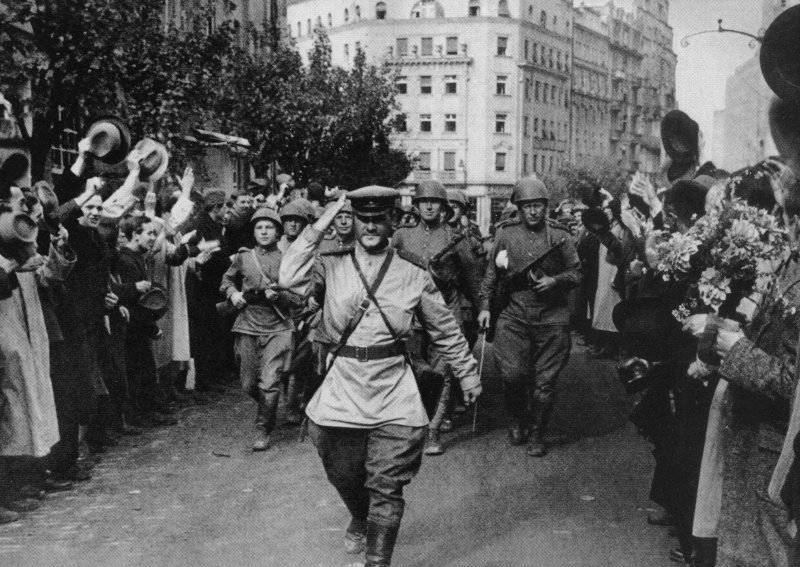
Belgrade offensive operation (September 28 - October 20 1944) was of particular importance to the peoples of Yugoslavia and the Soviet Union. It became a symbol of the military brotherhood of the peoples of the two Slavic powers, which in the most difficult times did not forget about their common origin.
Military-political situation
By the end of September 1944, the troops of the 2 and 3 of the Ukrainian fronts, defeating the large German groups on the southern wing of the Soviet-German front, opened their way to the capitals of Hungary and Austria - Budapest and Vienna - to the border of Yugoslavia. The Soviet troops forced the Danube into the 46 th army offensive zone and captured a bridgehead near the city of Turnu Severin. As a result, a threat was created to the communications of the German troops that operated in the southern part of the Balkan Peninsula and created conditions to assist the Yugoslav People’s Liberation Army (NOAJ) under the command of Josip (Joseph) Broz Tito. By this time, NOAJ controlled a significant part of Yugoslavia. However, the German troops and their local accomplices still held the main railway and automobile communications in their hands.
The peoples of Yugoslavia from all the occupied countries organized the most serious resistance to the invaders. By the end of 1943, NOAU numbered about 300 thousand fighters. Almost half of the entire territory of the country (mostly hard-to-reach areas) was cleared from the enemy. Moreover, this was done in the course of a brutal struggle with superior, well-armed and organized German troops, as well as collaborationists - Ustaša Pavelic, detachments of the Serbian General Milan Nedić (he headed the Government of National Salvation of Serbia), Chetnik Mikhailovich, who acted as representatives of the emigrant government and enjoyed the support of Great Britain and the United States, and other local nationalists.
In November 1943, the Anti-Fascist National Liberation Council of Yugoslavia (AVNOY) was transformed into the country's highest legislative and executive body. The National Committee for the Liberation of Yugoslavia (NPJA) was established. His head was Tito. As a result, in Yugoslavia, a new statehood was born and went through a period of formation, which began the transformation of a socialist nature. The Yugoslav immigrant government in London, which focused on Britain and the United States, was deprived of all rights. The question of the monarchy was to be decided by the people after the end of the war.
The German command, with the support of satellites and local collaborators, repeatedly attempted to suppress the Yugoslav partisans. For this purpose, they actively conducted terror and conducted large-scale military operations. In the spring of 1944, the Germans launched a new major offensive against the areas liberated by the partisans. However, they could not crush NOAJ. By the fall, the Yugoslav army numbered about 400 thousand fighters (50 divisions and a significant number of individual brigades and detachments) and represented a serious force. The main parts of the NOAA were land units, ready for autonomous operations. They had the old weapon, as well as weapons captured from the enemy, and received from the allies.
Moscow has consistently supported the struggle of the Yugoslav peoples against the invaders. In January, 1944 Moscow sent Yugoslavia a military mission led by Lieutenant General Korneyev. He was supposed to organize comprehensive help to NOAJ. Hundreds of tons of cargo were transferred to Yugoslavia: weapons, ammunition, ammunition, communications equipment, medicines, food. After the Red Army reached the borders of Yugoslavia, military material assistance increased sharply. In September, Tito visited Moscow. An agreement was reached on a joint operation of the Red Army and NOAJ. Later, on October 5, an agreement was signed on the joint actions of the Yugoslav and Bulgarian troops.
England and the United States during this period supported the emigrant government and wanted to preserve the old state system. At the same time, they tried to improve relations with NOAJ, sending their military missions to it. Assisting NOAJ, the Western powers continued to support the Chetyabs of Dragoljub Mikhailovich. In addition, Churchill hatched plans for the landing of British troops on the Adriatic coast. However, these plans were not implemented.
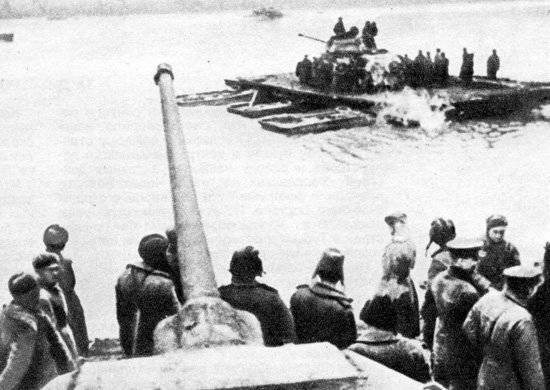
Crossing the Soviet troops across the Danube. October 1944
For the German military-political leadership, Serbia, due to its geographical location, was one of the most important areas of the Balkans. The German command throughout the war held significant forces here. With the advance of the Soviet armies through Romania and Bulgaria, with their access to the Danube, Serbia acquired even greater significance. At its eastern borders, it was decided to create a front and, under its cover, to withdraw troops from Greece and Macedonia.
Taking into account the serious change in the military-political situation, in the summer of 1944, the NOAJ command decided to shift the focus to Serbia. The troops that were already in Serbia, as well as several divisions from Montenegro, Sanjak and Eastern Bosnia (they were to break into Serbia), had to seize a significant part of the area and cut off enemy communications in the valley of the South and West Morava. In the summer of 1944, there were heavy battles between NOAJ units and German troops with their allies. The Germans could not stop the breakthrough of the large NOAU units in Serbia, although they suffered heavy losses. By the beginning of September, nine divisions of NOAJ had broken through to Serbia.
The possibility of a quick breakthrough of the Soviet troops and NOAJ in the Belgrade region created a threat to the German Army Group "E" to be cut off in Greece, and then destroyed. Therefore, at the end of August, the German command began to withdraw part of the forces from Greece and southern Yugoslavia to Banat and the eastern part of Serbia. In general, the troops of Army Group E planned to regroup into Belgrade and Budapest directions, where the outcome of the entire campaign on the southern wing of the Eastern Front was decided.
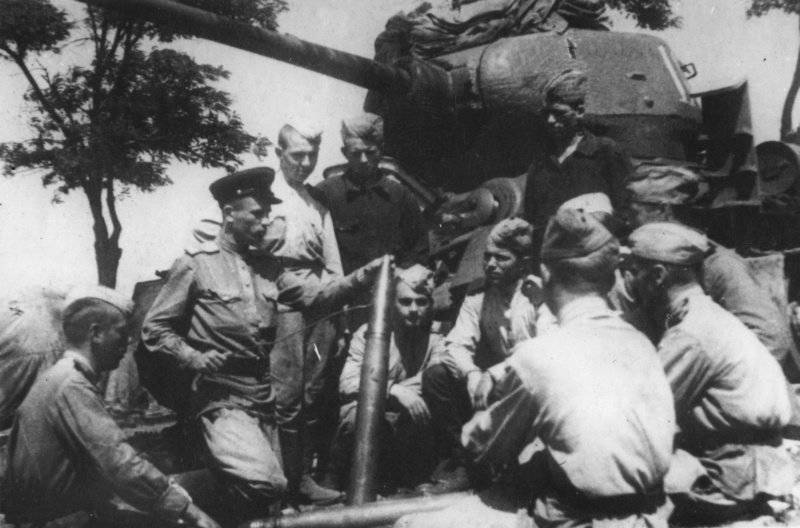
Young recruiting classes at the 4 Guards Mechanized Corps on the eve of the Belgrade operation
Plan of operation
The main objectives of the Belgrade operation were: the defeat of the German army group "Serbia" (part of the forces of Army Group "F") and the liberation of the remaining occupied areas of Serbia and Belgrade; access to the communications of Army Group “E” to prevent its peaceful withdrawal from the south of the Balkan Peninsula; the creation of a united front of the Soviet and Yugoslav troops, which facilitated the struggle of the PLA for the complete liberation of the country, and for the troops of the 3 of the Ukrainian front movement in the Budapest direction.
To accomplish these tasks, they planned to deliver two blows to the enemy. Soviet and Yugoslav troops struck at the main, Belgrade direction. Auxiliary attack, in the direction of Nis, was inflicted by the Yugoslav and Bulgarian troops. Moreover, the enemy was dealt a combined strike: the Red Army (the 3 of the Ukrainian Front and the Bulgarian units operatively subordinate to it, as well as part of the 2 of the Ukrainian Front) attacked from the east, and NOAU forces - from the west, south and east. In the course of the operation, the allied forces were to reach the line of the Danube-Obrenovac-Kragujevac-Knyazevac river. Having defeated the troops of the Serbia army groups, the Soviet and Yugoslav troops were to develop an offensive against Belgrade and free the Yugoslav capital. The withdrawal of the allied forces on the Morava River, as well as the success of the Yugoslav and Bulgarian offensive in the Niš area, made it possible to completely intercept the main communications leading from Skopje to Belgrade. And they planned to withdraw from Greece and Macedonia compounds of Army Group "E".
The main blow was dealt by the forces of the 57th Army and the 4th Guards Mechanized Corps from the Vidin area to Belgrade. The 57th Army was to break through the enemy’s defenses on the section from the Danube to Knyazhevac, overcome the East Serbian Mountains, and enter the valley of the river. Morava, providing the input in the battle of the second mobile echelon - mechanized corps. Subsequently, the troops of the 57th Army and the Guards Mechanized Corps in cooperation with the Danube Military flotilla should have developed an offensive in the Belgrade direction and liberated the capital of Yugoslavia. From the north, the advance of the 57th Army was provided by the 10th Guards Rifle Corps of the 46th Army of the 2nd Ukrainian Front, which was supposed to strike through Vrsac and go to the Yugoslav capital through the Pancevo area.
The 2 th Bulgarian army and the troops of the left flank of the 57 th army delivered an auxiliary strike from the Pirot-Rakovica area to Niš. They received the task of advancing into the valleys of the Western and Southern Morava rivers. At the same time, some of the Noahu units joined in the attack, whose attacks were planned both in Belgrade and Kruševac, Nis.
The forces of the parties
Germany. Army Group F was located on the Balkan Peninsula under the command of Field Marshal Maximilian von Weichs, who was also Commander-in-Chief of the German forces in the Southeast and Army Group E under the command of Colonel-General Alexander Löhr. Weihsu was subordinate to the troops stationed in Croatia, Bosnia and Herzegovina, Montenegro and Albania, in Serbia and forces stationed in Greece along with the islands (Army Group E). Army Group F included the 2nd tank Army and Army Group Serbia. The composition of Army Group E included: the 68th Army Corps in Athens and the Peloponnese; 22nd Mountain Corps in Western Greece; three serf brigades on the Ionian Islands; 91st Army Corps in Thessaloniki; the combat command of the island of Crete; combat command of the southern Aegean Sea (assault division "Rhodes" and the serf brigade). In total, German troops totaled about 400 thousand people.
On the territory of Yugoslavia proper, there were 14 full and 8 incomplete German divisions, a large number of separate and special battalions and regiments (about a thousand total 200). The Belgrade group was armed with about 2 thousand guns and mortars, 150 tanks and assault guns and 350 aircraft. In late September and early October, the Belgrade grouping was reinforced by regimental groups that moved from Greece and other areas. But most of the units did not have time to arrive at the battle site on time, due to the rapid breakthrough of the Red Army and NOAJ in the valley of the Morava River and to Belgrade.
In addition, units of five divisions and other units of the Hungarian army (about 30 thousand people) were deployed in Yugoslavia (Vojvodina). Various forces of collaborators, local nationalists hostile to the NOAJ and the Red Army represented a great force. So only the armed formations of the “independent” Croatian state numbered about 150 thousand people. They were stationed in Croatia, Srem, Bosnia and Herzegovina. The forces of the Chetniks numbered about 60 thousand people. The non-Serbian state security in Serbia is about 17 thousand, the Russian White Guard guard corps in Serbia is about 6 thousand, the Muslim militia in Bosnia and Herzegovina is about 4 thousand, etc. The total strength of the collaborators and nationalists was about 270 thousand people. However, due to decomposition and fluctuations in parts of local traitors, as well as a sharp increase in NOAJ, they had a low combat capability.
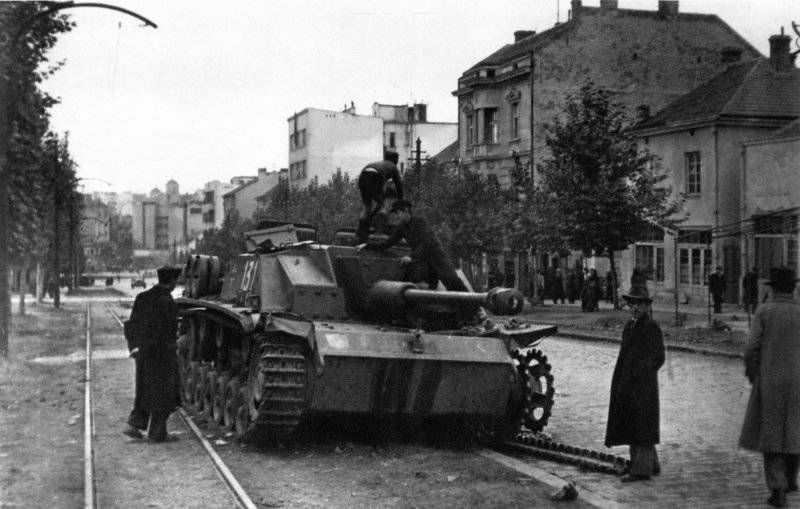
Wounded German self-propelled gun StuG III in Belgrade
Allied forces
The basis of the grouping of Soviet troops in the Belgrade operation was the troops of the 3-th Ukrainian and 2-th Ukrainian fronts. The 3 Army (57, 64 and 68 rifle corps), 75 Guards Mechanized Corps, 4-Rifle Division of front submission, 236-I separate guards, 5-guards, guards Brigade and 1-th Guards Fortified. The actions of the front supported 17-I Air Army and the Danube Flotilla. The 10 Guards Rifle Corps of the 46 Army of the 2 Ukrainian Front also supported the offensive. He was supported from the air by part of the 5 Air Force. For the breakthrough of the German defense, 3 artillery divisions of the breakthrough, 5 anti-aircraft artillery divisions, up to 50 separate artillery and mortar regiments were involved. In total, only 57 and 46 army were about 190 thousand people.
In addition, the troops of the government of the Patriotic Front of Bulgaria were in operational subordination of the 3-th Ukrainian Front: the 1-I, 2-I and 4-I armies (9 divisions and 3 separate brigades, including tank).
NOAU numbered about 400 thousand fighters - 14 corps (50 divisions) and a large number of different individual compounds. The 4 army corps (15 divisions), combined into 2 army groups, participated directly in the Belgrade operation. The 1 Army Group under the command of General Peko Dapchevich in the 1 Proletarsky and 12 Army Corps operated in the Belgrade area. The 2 Army Group, under the leadership of General Koch Popovich, consisted of the 13 and 14 Army Corps. The 13 Corps acted on the Niš direction.
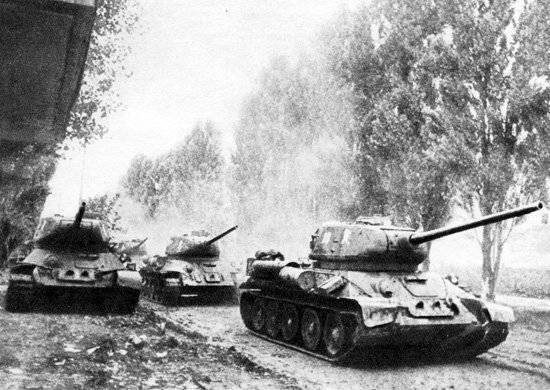
Soviet tankers are pursuing a retreating enemy. October 1944
Course of operation
On September 28, the troops of the 3 of the Ukrainian Front crossed the Yugoslav border and launched an offensive. The troops of the 57 Army, commanded by General Nikolai Gagen, were advancing from the Vidin area towards Belgrade. Already on September 30, the soldiers of the 68 Infantry Corps, together with the sailors of the Danube military flotilla, took a powerful knot of defense, blocking the way for our troops deep into Serbia, the city of Negotin. Residents of this Serbian city enthusiastically greeted the liberators. The Serbs expressed their ardent love to the liberators as best they could. October 3 was taken a major industrial center of the city of Bor.
The offensive ground forces actively supported the 17-I air army of General Vladimir Sudets. Even before the start of the operation, it was divided into two groups: the northern and the southern. The northern group was based on airfields in the region of Vidin and supported the 57 army offensive. The southern group supported the actions of the Bulgarian and Yugoslav forces in the Niš area. She received the task of striking communications and enemy backfields in the areas of Niš, Skopje and Kruševac. These attacks were to prevent the German command from sending troops from southern Yugoslavia and Greece to the north.
By October 10, Soviet troops crossed the East Serbian mountains, and reached the valley of the Morava River (advanced units reached the October 8 river). Actively contributed to the offensive of the Soviet troops 14 Corps NOAJ. In addition, the right flank of the army of Gagen provided the Danube military flotilla under the command of Sergei Gorshkov. The Soviet forces forced Morava and captured bridgeheads in the Veliky Plany area. It should be noted that an important part in overcoming the East-Serbian mountains was played by the engineering units of the front under the command of Colonel General of the engineering troops L. 3. Kotlyara. Sappers restored and built new bridges, cleared mines and repaired roads, cleared debris, removed mines. Their dedicated work allowed to proceed without delay to the second part of the operation.
On the right flank of the advancing 46-I army of Ivan Shlyomin. The 46 Army formations also successfully broke down enemy resistance, providing troops advancing on Belgrade from the northeast. The 10 Guards Rifle Corps liberated the city of Pancevo. Then the 46 Army strike group reached the 40-kilometer stretch to the Danube and, together with the NOAJ units, captured a bridgehead in 10 km northeast of Belgrade. Thus, conditions were created for the liberation of the Yugoslav capital. At the same time, on the left flank, the troops of the Bulgarian army from the west approached Leskovac, and from the west the 13 corps of the Yugoslav army approached it.
With the release of Soviet troops in the Moravian Valley, opportunities for maneuvering improved. On October 12, the Soviet command brought the 4 Guards Mechanized Corps of General Vladimir Zhdanov into battle. The Germans stubbornly resisted, created strong infantry barriers with reinforced artillery, tanks, assault guns and other means. However, they could not stop the offensive outburst of the Soviet troops. On the first day, they joined the units of the 21 Serbian division of the 1 Corps NOAJ. Yugoslav soldiers were put on armor and rushed to Belgrade. October 14 Soviet tankers, in cooperation with the troops of the 1-th Proletarian Corps, General Peko Dapchevich (from the 1-th Army Group) went to the outskirts of the Yugoslav capital. At the same time, the troops of the 12 of the Yugoslav Corps, under the command of General Danilo Lekic, were moving towards Belgrade from the south-west.
I must say that the locals greeted the Soviet tankers simply enthusiastically. In the corps newspaper Stalingradets, tank gunner Sergeant I. Y. Ivanov noted: “When we entered the village, it was impossible to drive down the street. All were people. They cluttered the roads and surrounded the tanks. Gave us gifts. Everyone carried what he could ... "
The storming of the city began after a strong artillery preparation. On the same day the outer defensive line was broken. Soviet and Yugoslav troops began a battle in the southern outskirts of the city. But then the battles took on a fierce character. The garrison numbered over 20 thousand soldiers with 40 tanks and 170 guns and mortars. The city was heavily mined, making it difficult to attack. The German command decided to sacrifice the Belgrade garrison in order to tie up the greatest possible number of Soviet and Yugoslav troops with the stubborn defense of the city, ensuring the withdrawal of other forces.
The battle for Belgrade was hard. German troops stubbornly resisted. Some strong points changed hands several times. In addition, part of the forces was diverted to the elimination of the "boiler" southeast of Belgrade, where 20-thousand continued to resist. enemy grouping. This "pot" by the joint efforts of the Soviet and Yugoslav forces was eliminated by October 19.
Most of Belgrade was released by the end of 15 October. October 20 Yugoslav capital was completely cleared of the Nazis. The last heavy fighting went on in the area of Kalemegdan, the Old Fortress. During the battle for Belgrade, 15 thousand were killed and 9 thousand German soldiers were captured. In pursuit of the enemy, Soviet troops reached the Rum area.
On October 21, Marshal Tito sent a letter to Tolbukhin, commander of the 3 Ukrainian Front, in which he thanked the soldiers, officers and the General of the Red Army, who, together with NOAJ units, liberated Belgrade. October 21 Soviet troops liberated Kraljevo, finally cutting off Thessaloniki - Belgrade. The 2-I Bulgarian Army in cooperation with the 13-Corps PLA released. Cities Niš and Leskovac.
After the liberation of Belgrade, the Soviet formations, according to the instructions of the Headquarters, were ordered to go on the defensive and do not move inland. For political reasons, the Yugoslav Army was given the opportunity to complete the complete liberation of Yugoslavia. Using the defeat of the Serbian army group and the sharp deterioration in the maneuvering capabilities of the German army, as well as Soviet military assistance, the Yugoslav troops reached the line of the Drina River by the end of October.
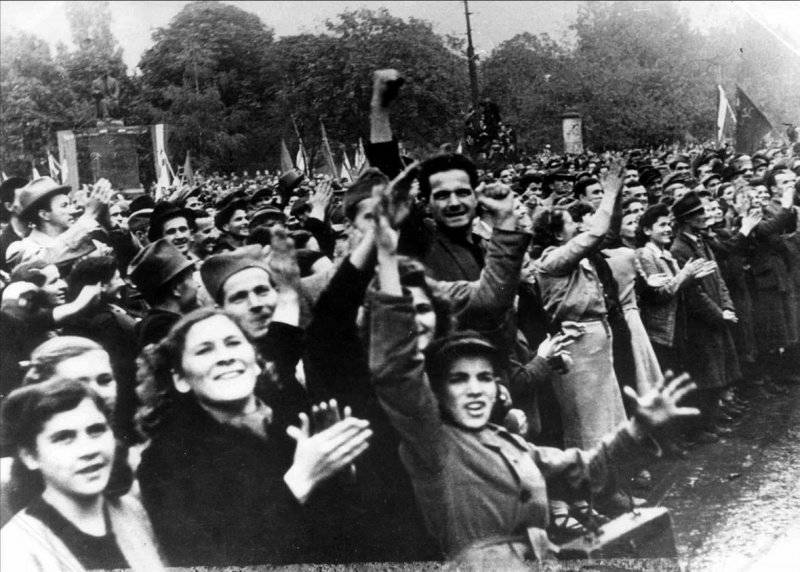
Residents of the Belgrade suburb of Vuk meet liberators
Results
Soviet, Yugoslav and Bulgarian troops inflicted a heavy defeat on the German Army Group F. The eastern and northeastern regions of Yugoslavia and its capital, Belgrade, were liberated from the Germans. Favorable conditions were created for the attack on Budapest. German troops lost up to 45 thousand people during this operation (according to other sources, German losses were much higher). The losses of the Soviet troops amounted to 18,8 thousand people (of which 4,3 thousand people killed).
The German command was forced to accelerate the evacuation of its connections from the southern part of the Balkans. German troops stationed in Greece were forced to retreat north, bypassing the hard-to-reach, mountainous regions of Bosnia and Montenegro. They were controlled by partisans, so the withdrawal led to large losses in manpower. In addition, the German troops had to abandon most of the equipment, stocks of ammunition and food. All this prevented the formation of Army Group F to take part in the battle for Hungary in a timely manner.
The defeat of the German Belgrade group was crucial for the liberation of the rest of Yugoslavia. Soviet troops operating in Yugoslavia were soon redeployed to Hungary. The Yugoslav army then continued to assist with the supply of weapons, equipment, ammunition and food. Based on this assistance, by the end of the year, NOAJ fully liberated the territory of Serbia, Montenegro and Macedonia from the enemy. German troops were able to stay only in the north-west of Yugoslavia.
The victories of the Soviet troops in the Balkans had a serious impact on the development of events in Greece and Albania. The change in the overall military-political situation allowed the People’s Liberation Army of Albania, which numbered several tens of thousands of fighters, to clear the southern and central parts of the country from the enemy. After days of stubborn fighting, the capital, Tirana, was liberated. In late November, the Albanian troops liberated the northern regions of Albania.
In Greece, the resistance of the occupier encompassed the widest sections of the population. Despite the most brutal terror and repression, the People’s Liberation Front united more than 1 million people. The People’s Liberation Army numbered 125 thousand people in its ranks. Socialist and communist sentiments prevailed among the people's liberation forces. Therefore, with the natural course of the event, Greece could in the future enter the socialist bloc. However, this process suppressed outside interference. October 4 1944, the day after Adolf Hitler ordered the withdrawal of troops from Greece, British troops began to land on its territory. On their bayonets, the emigrant government was entrenched in Greece. England, in coordination with the United States, launched a civil war in Greece that lasted until the 1949 year.
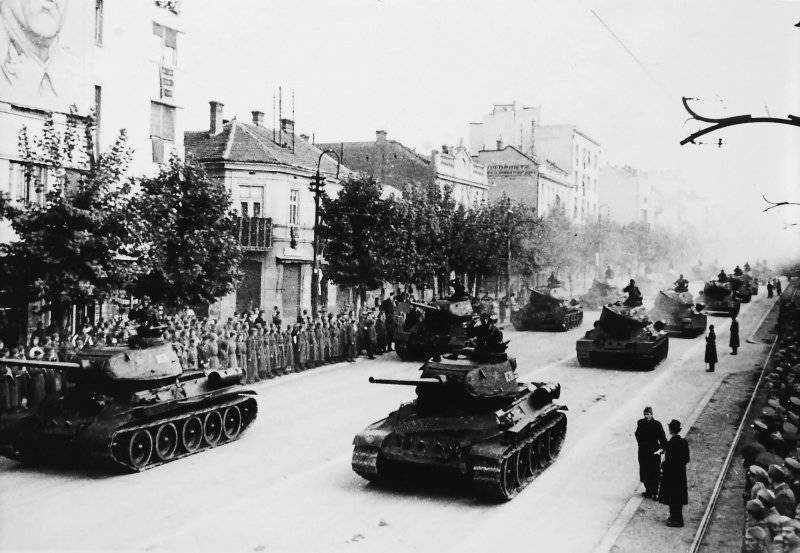
Noah’s T-34-85 tanks are on parade in honor of the anniversary of the liberation of Belgrade
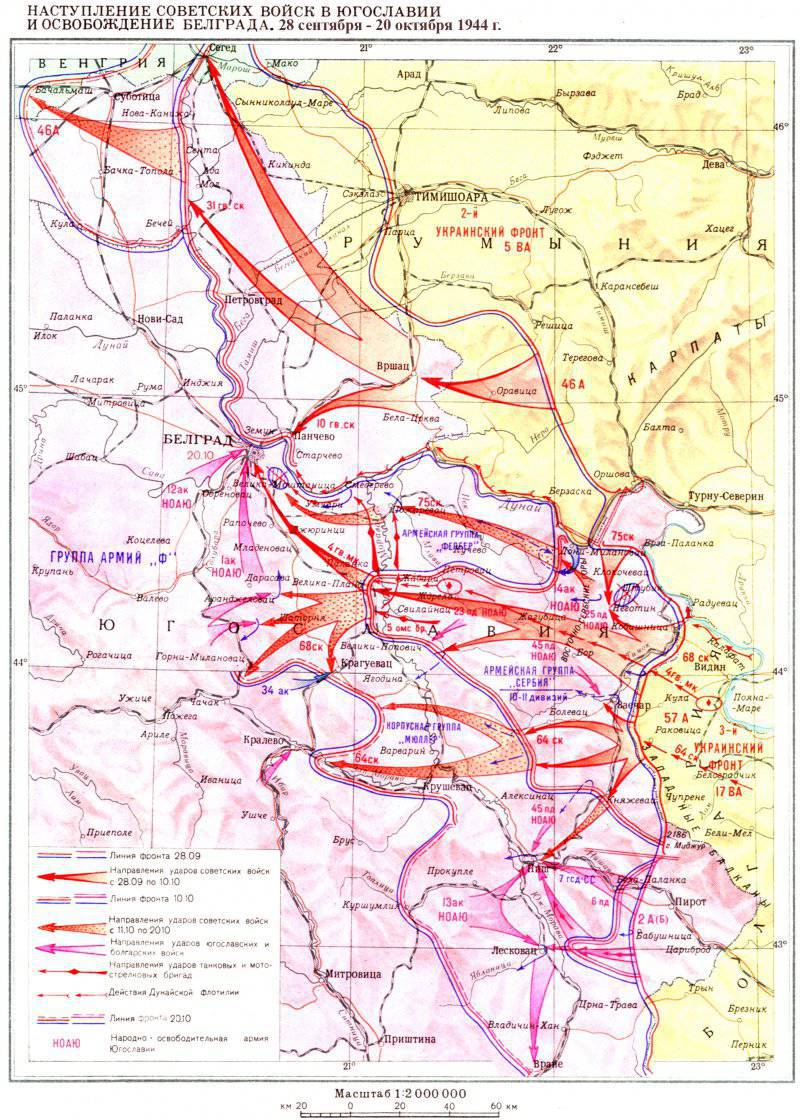
Information